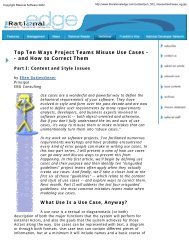Steps for Facilitating the Wall of Wonder - EBG Consulting
Steps for Facilitating the Wall of Wonder - EBG Consulting
Steps for Facilitating the Wall of Wonder - EBG Consulting
Create successful ePaper yourself
Turn your PDF publications into a flip-book with our unique Google optimized e-Paper software.
419 Hudson Road • Sudbury, MA 01776<br />
Phone: 978.261.5552 • Fax: 978.261.5552 • www.ebgconsulting.com<br />
<strong>Steps</strong> <strong>for</strong> <strong>Facilitating</strong> <strong>the</strong> <strong>Wall</strong> <strong>of</strong> <strong>Wonder</strong> (WoW)<br />
In my October 2008 feature article on Modern Analyst, “Exploring Requirements with a <strong>Wall</strong><br />
<strong>of</strong> <strong>Wonder</strong>”, I discuss using a storyboarding collaboration pattern dubbed, “<strong>Wall</strong> <strong>of</strong><br />
<strong>Wonder</strong>”. It is based on an approach to storyboarding I learned from <strong>the</strong> Institute <strong>of</strong> Cultural<br />
Affairs. (From <strong>the</strong> original article: “The group uses text or diagrams to build requirements, an<br />
iteration plan, or o<strong>the</strong>r important deliverables by successively using individual, subgroup, and whole<br />
group activities to generate items such as desired project features, business rules, use cases or user<br />
stories, data elements, screen navigations, and so on. I call it a <strong>Wall</strong> <strong>of</strong> <strong>Wonder</strong> (WoW) because <strong>of</strong> <strong>the</strong><br />
wondrous results groups can achieve.”).<br />
Figure 1 illustrates <strong>the</strong> process. Following is a detailed description <strong>of</strong> <strong>the</strong> steps:<br />
1. Make individual listings.<br />
a) Briefly explain <strong>the</strong> overall flow to prepare participants. Make sure <strong>the</strong>y have paper<br />
or cards, and <strong>the</strong>n ask <strong>the</strong> focus question. (Remember, <strong>the</strong> focus question sets <strong>the</strong><br />
content <strong>for</strong> <strong>the</strong> <strong>Wall</strong> <strong>of</strong> <strong>Wonder</strong> and is critical to <strong>the</strong> process).<br />
b) Ask <strong>the</strong> focus question. Allow people to think and brainstorm alone <strong>for</strong> five to<br />
seven minutes, listing <strong>the</strong>ir answers on <strong>the</strong> card or paper.<br />
c) Ask participants to mark <strong>the</strong>ir top three items, <strong>the</strong>reby sorting those <strong>the</strong>y consider<br />
most important, relevant, useful, or critical. I prefer to give <strong>the</strong>m a neutral criterion <strong>for</strong><br />
sorting by saying, ʺDraw a star next to your top three items.ʺ<br />
2. Assign one item per card, in subgroups.<br />
Divide <strong>the</strong> group into subgroups. Determine <strong>the</strong> subgroups ahead <strong>of</strong> time or <strong>for</strong>m<br />
<strong>the</strong>m at this point. The task <strong>of</strong> <strong>the</strong> subgroups is to arrive at a list <strong>of</strong> items in response to<br />
<strong>the</strong> focus question by sharing, merging, converging, and adding to <strong>the</strong>ir cards. Shoot<br />
<strong>for</strong> seven to nine items, creating a card <strong>for</strong> each. I usually have <strong>the</strong> group choose a<br />
leader to keep <strong>the</strong>m on task and on time and a recorder to do <strong>the</strong> recording <strong>for</strong> <strong>the</strong><br />
group. I instruct <strong>the</strong> recorders to:<br />
• Use a black marker to write one item per card.<br />
• Describe <strong>the</strong> item with three to five words (cut to <strong>the</strong> chase).<br />
• Write big.<br />
<strong>EBG</strong> <strong>Consulting</strong>, Inc. October, 2008<br />
Copyright © <strong>EBG</strong> <strong>Consulting</strong>, Inc., 2008 Page 1 <strong>of</strong> 3 www.ebgconsulting.com
www.ebgconsulting.com<br />
3. Post cards on <strong>the</strong> wall.<br />
Reconvene as a whole group. Ask <strong>for</strong> one card per group using questions such as<br />
ʺWhich card was most obvious to your subgroupʺ ʺWhich card did you select <strong>the</strong><br />
quickestʺ or ʺWhich is your most controversial cardʺ As you place each card on <strong>the</strong><br />
wall, read it exactly as it is written and ask <strong>the</strong> group if <strong>the</strong>y have clarifying questions. If<br />
<strong>the</strong>re are any questions or puzzled looks, ask <strong>the</strong> team members who wrote <strong>the</strong> card to<br />
explain its meaning and intent. Continue this process until all detail cards are posted.<br />
4. Group cards.<br />
As this process unfolds, guide <strong>the</strong> team in grouping <strong>the</strong> cards. (Often, participants<br />
intuitively start to tell you to do this. If <strong>the</strong>y donʹt, ask <strong>the</strong>m whe<strong>the</strong>r anything on <strong>the</strong><br />
wall ʺgoes toge<strong>the</strong>r.ʺ) Moving <strong>the</strong> cards, <strong>for</strong>m columns or clusters, depending on <strong>the</strong><br />
deliverable. Create new cards whenever a new item arises, when an item needs to be<br />
clarified, or when header cards are suggested.<br />
5. Create header cards.<br />
Create a header card <strong>for</strong> all groups or clusters. If you were writing a header card <strong>for</strong><br />
data elements in a data model, <strong>for</strong> example, <strong>the</strong> header card would be <strong>the</strong> name <strong>of</strong> <strong>the</strong><br />
data entity or business object to which <strong>the</strong> data element belongs. If you already have<br />
header cards from an earlier step, <strong>the</strong>n ask participants to reconsider <strong>the</strong> label and<br />
ensure that it is still relevant and meaningful.<br />
6. Analyze groupings.<br />
a) Extend <strong>the</strong> content <strong>of</strong> <strong>the</strong> wall by asking everyone to review his or her original list.<br />
As <strong>the</strong>y do this, ask <strong>the</strong>m whe<strong>the</strong>r any cards should be added.<br />
b) Quality check <strong>the</strong> end product (see Table 2 <strong>for</strong> examples), and <strong>the</strong>n use your<br />
decision rule process to reach closure. (3)<br />
Note: As a follow‐up to creating <strong>the</strong> <strong>Wall</strong> <strong>of</strong> <strong>Wonder</strong>, consider conducting a structured discussion <strong>of</strong><br />
<strong>the</strong> wallʹs contents. Ask <strong>the</strong> group to reflect on both <strong>the</strong> product <strong>the</strong>y created (and its implications <strong>for</strong><br />
<strong>the</strong> project) and on <strong>the</strong> process <strong>the</strong>y used to create it. Pausing to debrief ‐‐ to process both your product<br />
and your process ‐ <strong>of</strong>fers rich learning opportunities and is <strong>the</strong> mark <strong>of</strong> a truly collaborative team.<br />
<strong>EBG</strong> <strong>Consulting</strong>, Inc. October, 2008<br />
Copyright © <strong>EBG</strong> <strong>Consulting</strong>, Inc., 2008 Page 2 <strong>of</strong> 3 www.ebgconsulting.com
www.ebgconsulting.com<br />
Figure 1: <strong>Wall</strong> <strong>of</strong> <strong>Wonder</strong> Process<br />
Reference:<br />
Gottesdiener, Ellen. Requirements by Collaboration: Workshops <strong>for</strong> Defining Needs, Addison‐Wesley, 2002.<br />
<strong>EBG</strong> <strong>Consulting</strong>, Inc. October, 2008<br />
Copyright © <strong>EBG</strong> <strong>Consulting</strong>, Inc., 2008 Page 3 <strong>of</strong> 3 www.ebgconsulting.com















